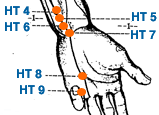HT 9
Acupuncture Point Theory
HT 9 Acupuncture Point Applications and Theory
 The acupuncture point "HT 9" , 少沖, is represented by "Shao Chong" in pinyin and "Lesser Surge" in english and may be found:
The acupuncture point "HT 9" , 少沖, is represented by "Shao Chong" in pinyin and "Lesser Surge" in english and may be found:
.1 cun posterior to the corner of the nail on the radial side of the little finger.
Of many possible clinical applications, it may be considered to influence the following issues/symptoms:
- Jing Well Point - clear heat a/or obstruction from the opposite end of the channel, eye pain a/or redness, mouth ulcerations, sores.
- Can be bled or needled for emotional disturbances - strong restlessness, anxiety, panic attacks, manic depression, epilepsy, etc.
- Restore consciousness - heart attack, stroke.
- Emergency heart attack point - strong stimulation.
- Fullness below the heart - stagnation, pain a/or distention in the HT area.
Ht 9 has the following theoretical associations which serve as important guideposts in designing an effective treatment protocol:
Explore ht 9 functional groupings theory - Entry Exit Point and/or Five Shu, or read all point categories and related theory.
A single acupuncture point is not commonly thought of as an empirical way to influence a TCM diagnostic pattern. HT9, however, is a strong candidate to be incorporated into an acupuncture protocol for patients who exhibit: Heart Blood Stagnation
HT 9 may potentially be used, in coordination with a well designed acupuncture treatment protocol, to influence the following conditions: Anxiety, Canker Sores (Cold Sores), Epilepsy (Seizure), Eye Problems, Fainting (Loss of Consciousness), Heart Disease, Manic Depression, Panic Attack and/or Stroke (CVA)
While not necessarily valid clinically, SI 1 (Breast disorders of any etiology, insufficient la…) and TH 1 (Similar to TH 3 which is used more clinically. ) are nearby.
All Content 1999-2025
Chad J. Dupuis / Yin Yang House
Our Policies and Privacy Guidelines
Our Affiliated Clinics
